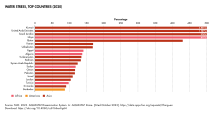සුඩානයේ භූගෝලය


සුඩානය උතුරු අප්රිකාවේ පිහිටා ඇති අතර රතු මුහුදට මායිම්ව කිලෝමීටර 853 (සැතපුම් 530) වෙරළ තීරයක් ඇත.[1] එය ඊජිප්තුව, එරිත්රියාව, ඉතියෝපියාව, දකුණු සුඩානය, මධ්යම අප්රිකානු ජනරජය, චැඩ් සහ ලිබියාව සමඟ ගොඩබිම් මායිම් ඇත. වර්ග කිලෝමීටර 1,886,068 (වර්ග සැතපුම් 728,215) ක භූමි ප්රමාණයකින් යුත් එය මහාද්වීපයේ තුන්වන විශාලතම රට (ඇල්ජීරියාව සහ කොංගෝ ප්රජාතන්ත්රවාදී ජනරජයට පසුව) සහ ලෝකයේ පහළොස්වන විශාලතම රට වේ.
සුඩානය පිහිටා ඇත්තේ 8° සහ 23°N අක්ෂාංශ අතර ය. භූමි ප්රදේශය සාමාන්යයෙන් සමතලා තැනිතලා වන අතර කඳු වැටි කිහිපයකින් කැඩී යයි. බටහිරින්, මාරා කඳුකරයේ පිහිටා ඇති ඩෙරිබා කල්දේරා (මීටර් 3,042 හෝ අඩි 9,980) සුඩානයේ උසම ස්ථානය වේ. නැගෙනහිරින් රතු මුහුදේ කඳු පිහිටා ඇත.[2]
නිල් නයිල් සහ සුදු නයිල් ගංගා කාර්ටූම්හිදී හමු වී නයිල් නදිය සාදයි, එය ඊජිප්තුව හරහා උතුරු දෙසට මධ්යධරණී මුහුදට ගලා යයි. සුඩානය හරහා නිල් නයිල් මාර්ගය කිලෝමීටර 800 (සැතපුම් 497) පමණ දිග වන අතර සෙන්නාර් සහ කාර්ටූම් අතර ඩින්ඩර් සහ රහඩ් ගංගා එකතු වේ. සුඩානය තුළ සුදු නයිල් ගඟට සැලකිය යුතු අතු ගංගා නොමැත.
නිල් සහ සුදු නයිල්ස් මත වේලි කිහිපයක් තිබේ. නිල් නයිල් ගඟේ සෙන්නාර් සහ රොසයිරස් වේල්ල සහ සුදු නයිල්හි ජෙබෙල් අවුලියා වේල්ල ඒ අතර වේ. සුඩාන-ඊජිප්තු දේශ සීමාවේ නුබියා විල ද ඇත.
ඇස්බැස්ටස්, ක්රෝමයිට්, කොබෝල්ට්, තඹ, රන්, ග්රැනයිට්, ජිප්සම්, යකඩ, කයෝලින්, ඊයම්, මැංගනීස්, මයිකා, ස්වාභාවික වායු, නිකල්, පෙට්රෝලියම්, රිදී, ටින්, යුරේනියම් සහ සින්ක් ඇතුළු පොහොසත් ඛනිජ සම්පත් සුඩානයේ ඇත.[3]
දේශගුණය
[සංස්කරණය]දකුණු දෙසට වර්ෂාපතනය වැඩි වේ. මධ්යම සහ උතුරු කොටසෙහි ඊසාන දෙසින් නූබියන් කාන්තාරය සහ නැගෙනහිරින් බයුඩා කාන්තාරය වැනි අතිශය වියළි, අර්ධ කාන්තාර ප්රදේශ ඇත; දකුණේ තණබිම් සහ නිවර්තන සැවානා ඇත. සුඩානයේ වැසි සමය උතුරේ මාස හතරක් (ජූනි සිට සැප්තැම්බර් දක්වා) සහ දකුණේ මාස හයක් (මැයි සිට ඔක්තෝබර් දක්වා) පවතී.
වියළි ප්රදේශ හබූබ් ලෙස හැඳින්වෙන වැලි කුණාටු වලින් පීඩා විඳිති, එමඟින් සූර්යයා සම්පූර්ණයෙන්ම අවහිර කළ හැකිය. උතුරු හා බටහිර අර්ධ කාන්තාර ප්රදේශවල මිනිසුන් මූලික කෘෂිකාර්මික කටයුතු සඳහා හිඟ වර්ෂාපතනයක් මත යැපෙන අතර බොහෝ දෙනෙක් සංචාරක, බැටළුවන් සහ ඔටුවන් සමඟ ගමන් කරති. නයිල් නදිය ආසන්නයේ, මුදල් බෝග වගා කරන ළිං වාරි ගොවිපලවල් ඇත.[4] හිරු එළිය රට පුරා ඉතා ඉහළ නමුත් විශේෂයෙන් එය වසරකට පැය 4,000 කට වඩා වැඩි විය හැකි කාන්තාරවල.
පාරිසරික ගැටළු
[සංස්කරණය]
කාන්තාරකරණය සුඩානයේ බරපතල ගැටලුවකි.[5] පාංශු ඛාදනය ගැන ද කනස්සල්ලක් ඇත. කෘෂිකාර්මික ව්යාප්තිය, රාජ්ය සහ පෞද්ගලික යන දෙඅංශයෙන්ම, සංරක්ෂණ පියවරකින් තොරව සිදු වී ඇත. එහි ප්රතිවිපාක වන විනාශය, පාංශු වියළීම සහ පාංශු සාරවත් බව සහ ජල මට්ටම පහත වැටීමේ ස්වරූපයෙන් ප්රකාශ වී ඇත.[6]
දඩයම් කිරීම නිසා ජාතියේ වන සතුන් තර්ජනයට ලක්ව ඇත. 2001 වන විට ක්ෂීරපායී විශේෂ විසි එකක් සහ පක්ෂි විශේෂ නවයක් මෙන්ම ශාක විශේෂ දෙකක් ද වඳවීමේ තර්ජනයට ලක්ව ඇත. දැඩි ලෙස වඳවීමේ තර්ජනයට ලක්ව ඇති විශේෂවලට ඇතුළත් වන්නේ: වැල්ඩ්රැප්, උතුරු සුදු රයිනෝසිරස්, ටෝරා හාර්ට්බීස්ට්, සිහින් අං සහිත ගැසල් සහ උකුස්සන් කැස්බෑවා. සහරා ඔරික්ස් වනයේ වඳ වී ගොස් ඇත[7]
වනජීවී
[සංස්කරණය]
සුඩානයේ වන ජීවීන් එහි වෘක්ෂලතා සහ සත්ත්ව විශේෂ වලින් සමන්විත වේ. සුඩානයේ විවිධ දේශගුණික වර්ග නිසා පුළුල් පරාසයක වාසස්ථාන ඇති වන අතර වන ජීවීන්ගේ පරාසය විවිධාකාර වේ. රට තුළ ක්ෂීරපායී විශේෂ 287 ක් සහ පක්ෂි විශේෂ 634 ක් පමණ වාර්තා වී ඇත.
යොමු කිරීම්
[සංස්කරණය]- ^ "Sudan geography". Institute for Security Studies. 12 January 2005. 13 May 2011 දින මුල් පිටපත වෙතින් සංරක්ෂණය කරන ලදී.
- ^ "Sudan". Country Studies. n.d. සම්ප්රවේශය 26 June 2010.
- ^ "Geography of Sudan". Sudan Embassy in London. n.d. 30 September 2005 දින මුල් පිටපත වෙතින් සංරක්ෂණය කරන ලදී.
- ^ "Sudan – Geography & Environment". Oxfam GB. n.d. 1 October 2012 දින මුල් පිටපත වෙතින් සංරක්ෂණය කරන ලදී. සම්ප්රවේශය 13 January 2011.
- ^ "Desertification & Desert Cultivation Studies Institute". University of Khartoum. n.d. 24 May 2013 දින මුල් පිටපත වෙතින් සංරක්ෂණය කරන ලදී. සම්ප්රවේශය 31 May 2013.
- ^ "Soil conservation and land reclamation in the Sudan". United Nations University. n.d. 28 May 2010 දින මුල් පිටපත වෙතින් සංරක්ෂණය කරන ලදී. සම්ප්රවේශය 26 June 2010.
- ^ [විශ්වසනීය මූලාශ්රය?] "Sudan – Environment". Encyclopedia of the Nations. n.d.. http://www.nationsencyclopedia.com/Africa/Sudan-ENVIRONMENT.html. ප්රතිෂ්ඨාපනය 13 January 2011.
